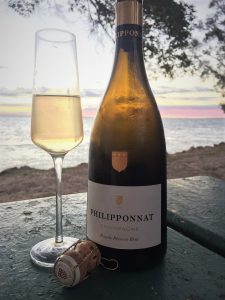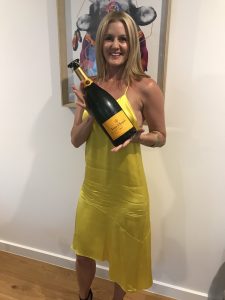
My Top Five Special Occasion Champagnes
- Marnie Nichols
- February 10, 2022
- All Time Favourites, Blog, Top Fives
“Always keep a bottle of champagne in the fridge for special occasions. Sometimes, the special occasion is that you have a bottle of champagne in the fridge.”
Hestor Browne
Special occasions champagnes
Over the years I have developed my own champagne hierarchy and based on the special-ness of the occasion, where I recommend champagnes based on an increasing scale of price, accessibility and taste.
This list of special occasion champagnes sit in the $80-$150 range and my other top five champagnes for different occasions are…
- every day (under $80)
- really special occasion champagnes ($150-$300) and
- really, really special occasion champagnes ($300 – $1000)
But let’s kick off this list of special occasion champagnes.
1. Charles Heidsieck Brut Reserve
Special occasion match – celebrating your own birthday or a special moment for yourself. (I have a tradition to drink a bottle every year for my birthday.)
If I want to spoil myself, this is where I will start.
Every time.
I love this wine.
I really love this wine!
When people ask me…
“What’s your favourite champagne?”
It’s hard to answer with just ONE champagne… it depends on my mood or the occasion or the budget BUT the Charles Heidsieck Brut Reserve will always feature somewhere in my answer.
And that is because it’s a truly spectacular non-vintage wine. In fact, you could be forgiven for mistaking it as a vintage or even cuvée de prestige champagne it’s that good.
Arguably the best NV champagne on the market, the Charles Heidsieck Brut Reserve manages to be complex with all the hallmarks of an aged champagne – honey, brioche, and velvety ripe fruit laced with vanilla – at the same time as being remarkably fresh. If I had to pick one champagne to drink every day for the rest of my life, this is it. Or if I could take just one champagne to take a deserted island, this is it.
Just having a glass of this champagne will make any moment a special occasion.
The Technical Details
The Blend
40% Pinot Noir
40% Chardonnay
20% Meunier
Blended from 60 crus (including grand crus, premier crus, and crus)
Dosage – 11 g/l
Aged – 3-4 years on lees
Reserve wines – 40% reserve wines, the average ten years but as old as 20 years
Fermentation – stainless steel tanks, cru by cru, variety by variety with full malolactic fermentation.
Total annual production – 1 million bottles
You can buy the Charles Heidsieck Brut Reserve from Dan Murphy’s for $97
Bubble & Flute Champagne Style* – Rich & Robust AND Bold & Adventurous
Read the full review of the Charles Heidsieck Brut Réserve here.

2. Philipponnat Royal Reserve Brut
Special occasion match – when you’re taking a break from the world and treating yourself to a long weekend away.
In my opinion, the Philipponat Royale Réserve is one the most under-rated NV Brut champagnes on the market. It has vastly more character and complexity than the big brands that you can find for around the same price point which is part of what makes it special – you will want to savour it for a special occasion rather than drinking it when you just feel like champagne.
I would describe the house style as powerful and distinctive. The team at Philipponnat walk to the beat of their own drum. They don’t yield to trends, staying true to their unique style which is characterised by more mature grapes and lower dosage. The house is based in Mareuil-sur-Ay… the terroir in this village is renowned for powerful, exciting pinot noir grapes.
A combination of the fruit from the village of Mareuil, barrel fermentation and perpetual solera reserve gives this champagne its edge. The way the ripe, red fruit flavours (particularly cherry fruit flavours) come together with the acidity and chalkiness of the chardonnay is really special and exciting.
The Philipponnat family has owned its land in Champagne since 1522 and is particularly famous for a single plot of land, the Clos des Goisses. (Clos in French means walled vineyard and Goisses means very steep slope.)
This very special 5.5 hectare plot is inclined at 45 degrees and faces due south – meaning it is never in shade – which has a unique effect on ripening the grapes grown here. The Clos des Goisses champagne is one for a very, very, very special occasion but the Royale Reserve Brut is a fave of mine for special occasions. And it’s not just me. Every time I serve this wine in a tasting, it is consistently named as a favourite.

The Technical Details
The Blend
65% Pinot Noir
30% Chardonnay
5% Meunier
Blended from mainly grand crus and premier crus.
Dosage – 8 g/l
Aged – 3 years on lees
Reserve wines – 20-30% reserve wines, aged in wooden barrels using the solera technique
Fermentation – stainless steel tanks with partial malolactic fermentation.
Total annual production – 500,000 bottles
When it’s in stock, You can buy the Philipponat Royale Réserve from Emperor for $85.
Bubble & Flute Champagne Style*– Rich & Robust
3. Louis Roederer Vintage Rosé
Special occasion match – getting the girls together for a celebration or just a long overdue catch-up
When I tasted the Loius Roederer Vintage Rosé for the first time, I was at a dinner with Louis Roederer cellar master, Jean-Baptiste Lécaillon. Jean-Baptiste proudly told us that his 2010 rosé had just been named the best rosé in the world. And that to win this award it had beaten his own current vintage Cristal Rosé, one of the most expensive wines on the planet! But far from being annoyed or disappointed, Jean-Baptiste was clearly immensely proud of his 2010 rosé because the award didn’t mean his Cristal Rosé was any less of a wine… just that the 2010 rosé was really quite remarkable.
I love listening to Jean-Baptiste talk about his wines. He brings poetry to champagne… just read how he describes his rosé…
“… the concentration, fruitiness, and compactness of the Cumières Pinot noir grapes are transcended by the elegance, purity, and freshness of the finest chardonnay grapes cultivated on the Côte des Blancs.”
Louis Roederer has developed a unique technique for producing its rosé champagnes, the ‘infusion’ technique. A small amount of chardonnay juice is added to the pinot noir maceration and are then fermented together.
Each vintage is slightly different of course, but it is generally blended with still red wine and made from 65-70% pinot noir and 25-30% chardonnay. As a result of the Roederer technique, I find the character of the chardonnay strikingly fresh, pure, and chalky, while still holding the exotic floral and spicy fruit notes without them dominating.
The Technical Details
The Blend for the 2013 Vintage
70% Cumières pinot noir;
30% Chouilly chardonnay,
Dosage – 8 g/l
Aged – 4 years on lees
Fermentation – co-fermentation of the pinot noir and chardonnay 33% fermented in oak casks, 22% malolactic fermentation
Total annual production – 1 million bottles
You can buy the Loius Roederer Vintage Rosé from Emperor for $135.
Bubble & Flute Champagne Style* – Classic & Smooth
4. Laurent-Perrier Rosé
Special occasion match – this is one for a special romantic occasion – relationship anniversary or for Valentine’s Day
Another rosé! Not a big surprise to see two rosés on my list because I love rosé. I think of it as a really special style of champagne and this is a list of champagnes for special occasions, making another rosé a fitting inclusion.
Rosé champagne gets a bit of a bad wrap from wine snobs. It’s looked at as being a bit light and not a very serious wine but that is definitely NOT the case for the Laurent-Perrier Cuvée Rosé.
The Laurent-Perrier Rosé is something else. I often pour this rosé for red wine lovers (and men) I am trying to convert to become champagne fans, particularly those who don’t think they like champagne and certainly not rosé.
Laurent-Perrier is actually a pretty big champagne brand – in fact, it’s the 5th highest selling house, and this rosé is the highest-selling rosé champagne in the world. And it is a BIG rosé to match the brand.
What makes it such a big rosé is that it is 100% pinot noir (from the best crus of Ambonnay, Bouzy, Louvois and Tours-Sur-Marne), aged on lees for five years, and made with the maceration technique (Read more about the technique here).
The Laurent-Perrier Rosé offers lots of lively berry fruits, redcurrant and blood orange. The palate has a great balance between uplifting acidity, freshly picked fruit, like black cherry and a marked vinous character that makes this such an interesting style.

The Technical Details
The Blend
100% Pinot Noir
Terroir – 10 different Crus located mainly in the South and North areas of the Montagne de Reims ‑ including the finest Crus from the famous Côte de Bouzy ‑ Ambonnay, Bouzy, Louvois and Tours‑sur‑Marne.
Maceration – The maceration lasts from 48 to 72 hours depending on the harvest to help the extraction of the colour and to obtain unequalled aromas, revealing all the richness of the best Crus of Pinot Noir.
Dosage – 8 g/l
Aged – 5 years on lees
Reserve wines – 20-30% reserve wines, aged in wooden barrels using the solera technique
Total annual production – The house produces about 7 million bottles each year
You can buy the Laurent-Perrier Cuvée Rosé. from Emperor for $130.
Bubble & Flute Champagne Style*– Rich & Robust
5. Anything en magnum
Special occasion match – this is a BIG bottle for a BIG party to mark a special occasion
Ahh – the age-old question… is bigger always better?
With champagne – if you are drinking from a magnum or (maybe) a jeroboam – YES*!
In big formats like magnums and jeroboams autolysis (read more here) takes longer (up to four weeks longer) and because these bottles have more glass surface area than standard bottles there is more contact between the lees sitting on the glass inside the bottle and the wine, which brings more roundness and much more complexity.
There’s also less oxidation in magnums and jeroboams, so the champagne ages better. Magnums/jeroboams hold two/four times the amount of wine, but they actually have the same space between the bottom of the cork and the wine’s surface, which can be a source of trace oxygen after disgorgement. The same amount of oxygen exposed to a greater volume of wine reduces oxidation (oxidation eventually turns wine into vinegar), and is the key difference in how the champagne better ages after disgorgement. It’s fresher but also more complex and intense from the autolysis.


*Footnote to bigger is better – this only holds for magnums or (maybe) jeroboam because most champagne houses only ferment in bottles up to a magnum (or some a jeroboam) because any larger than that and the risk of the bottle exploding is too great (read more here).
What do you drink for a special occasion? Next time your’re celebrating, make sure you post a pic and tag @bubbleandflute #happychamper #topfivechampagnes
*Bubble & Flute Champagne Style Guide
After more than a decade of champagne tastings with everyone from beginners to fully-fledged champs-snobs, I have developed a theory that everyone has a basic, favourite style of champagne they’ll always choose over everything else.
I have developed my Bubble & Flute Champagne Style to reveal your champagne style and suggest more champagnes to try, based on your style, that I think you are totally going to love!
Once you know your champagne style you will visit wine shops or shop online feeling more confident and comfortable selecting new champagnes because you know and understand what style of champagnes you like most.
My Top 5 Fantasy Valentine’s Day Dates And The Champagnes We’d Pop
Top Five Summer Champagnes
My Top Five Champagne Predictions for 2022
My Top Five Everyday Champagnes
My Top Five Beach Champagnes
My stand out champagnes from the last five years
My Top Five Party Champagnes
My top five winter champagnes
Christmas Champagne Gift Guide For The Champagne Obsessed
My Top Five Autumn Champagnes (2021)
Bubble & Flute promotes the responsible consumption of alcohol for individuals of legal drinking age in their country.



















